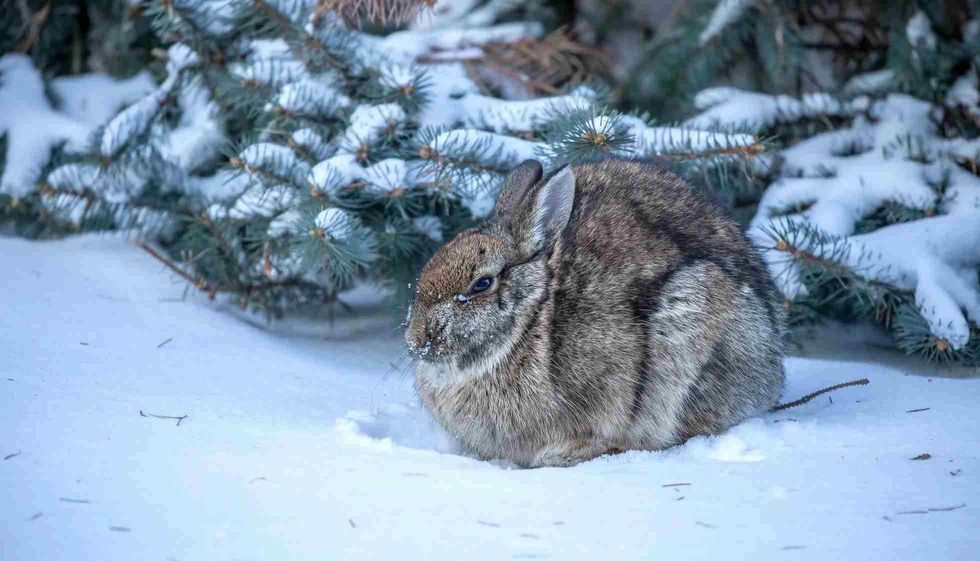Now here's a rabbit who knows how to keep its family line going! The cottontail rabbit is known for its prolific breeding skills.
It can reproduce multiple times in just a year and have tonnes of babies. However, they are also well known for their expert skills in making nests.
These rabbits can make nests out of almost anything possible, such as fur, grass, twigs, rocks, and a lot more. These nests can even be reused as per mating seasons.
In addition, when not spending time in their nests, you can see these little creatures bounding over land and snow across the United States. However, just because they look cute does not mean they are safe for you to touch.
If you wish to know more about the cottontail rabbit lifespan, its fur, if you can have a cottontail rabbit pet, the vegetation it lives in, and its distribution in said vegetation, then read on. Want to check out more exciting animals? Then do not forget to check out the mini satin rabbit and the Tolai hare too.
Cottontail Rabbit Interesting Facts
What type of animal is a cottontail?
This species located in New England is a type of rabbit.
What class of animal does a cottontail belong to?
Eastern cottontail rabbits belong to class Mammalia.
How many cottontails are there in the world?
In 2019, the statewide springtime population estimate for eastern cottontail rabbits was 8.5 rabbits per 1000 assessment mi (1609 km). There are about 13,000 New England cottontail rabbits that survive in the world, according to researchers. The presence of cottontail rabbits results in a healthy food chain.
Where does a cottontail live?
These eastern cottontails species of North America live in the Savanna. They are a very hardy species and can sustain themselves even in the harsh North American winters.
What is a cottontail habitat?
In south-central and the eastern United States, the eastern cottontail can be observed in shrubby and meadows environments. To forage, they go into yards and fields. Cottontail rabbits like new deciduous forests as well.
They sleep in grassy clumps, bushes, and thickets. Cottontail rabbit habitat can also occur in edge areas around marshes and swamps. At the same time, New England rabbits need young woodland, including shrubland habitats.
Who do cottontails live with?
Cottontail rabbits are solitary creatures who live in territories ranging in size from several acres to 100 acres. Males and females only meet to reproduce. However, European rabbits are gregarious animals that engage with one another.
How long does a cottontail live?
Cottontail rabbits' lifespan in the wild is approximately two years in a suitable environment, while in captivity, they can survive for around eight years. Rabbits are most active around dawn and twilight to avoid predators.
How do they reproduce?
Cottontail rabbits are known to be prolific breeders. The breeding season for cottontails runs from around January to June, with most young born in May-June.
The young of the eastern cottontail may be born in an old burrow or nest. The cottontail rabbit nest is made by a mother rabbit in tall grass, under heavy shrubs, or another protected location. The usual litter size is four kits; however, this can range from two to eight kits.
Mountain cottontail females species build a cup-shaped nest. Each year, mountain cottontail females can bear for to five litters.
The babies of cottontails are around 4 in (16 cm) long at birth, blind, deaf, and practically hairless, with flattened ears. Females care her babies by smothering them with leaves, grass, fur, and other fluffy debris.
In approximately a week, the eyes of the young will open. Young begins tentative forays from the nest in two weeks, and their long ears begin to rise from their flat state.
What is their conservation status?
According to the IUCN Red List conservation status of an eastern cottontail rabbit (scientific name: Lepus sylvilagus) is of Least Concern, while the New England cottontail is listed as Vulnerable.
Cottontail Rabbit Fun Facts
What do cottontails look like?

The eastern cottontail is chunky, gray-brown, or red-brown in color, with big back feet, elongated ears, and a small, fuzzy white-colored rear. The fur on its underside is white in color. Cottontails have huge, brown eyes that protrude from the edges of their heads.
These eyes provide them with 360-degree vision. It has a brownish-gray pigmentation around the neck and head, which distinguishes it from hares. Except for a tiny color difference, eastern New England cottontails are very indistinguishable in appearance.
How cute are they?
These short-faced bunnies with fluffy and velvety fur are, without a doubt, adorable. Cottontails and their New England cottontail relative, with their protruding eyes and wiggling noses, are exceedingly cute. However, they are also wild animals, and if seen outside, they should be avoided. These little creatures can have a nasty bite and can potentially carry rabies.
How do they communicate?
Cottontail rabbits are talkative animals that generate a variety of noises. They snarl and grunt, and if trapped by predators, they may shriek.
A cottontail also purrs by crushing its teeth. Yelping, screaming, or squealing is types of cottontail rabbit distress call. They can also be fairly aggressive, especially during mating season, and will not hesitate to hurt others of their own species.
How big is a cottontail rabbit?
The average length range of cottontail rabbits is around 15-18in (38-45.7 cm). The length range of desert cottontail rabbits is between 14-17 in (36-42 cm), which makes the cottontail rabbit size a little bit larger than desert cottontails.
How fast can a cottontail run?
Cottontail rabbits can sprint at speeds of up to 18 mph (30 kph) in a zig-zag pattern to deceive predators. Therefore, it is easy to see that the cottontail, also known as white cottontail, is an excellent runner.
However, they struggle in the water. When comparing the swamp rabbit vs. cottontail, we see that the swamp rabbit has webbed feet and can swim in the water much faster than the eastern cottontails.
How much does a cottontail weigh?
Cottontail rabbit weight measures around 2-4.5lb (.9-2 kg). The bodyweight of this species depends upon their environment. They tend to bulk up for the long winters but will be seen in their much lighter, natural body weight when in the summers.
What are the male and female names of the species?
Specifically, there is no name for both gender of the cottontail rabbit species, but the commonly female rabbits are titled does and males as bucks.
What would you call a baby cottontail?
There is no special name for the baby cottontail rabbit, while the baby rabbits are labeled kits.
What do they eat?
Cottontail rabbit diet includes grasses, sprouts, sedges, leaves, bark, fruits, and buds, among other plant items. Cottontail rabbit food comprises succulent annuals, legumes, weeds, grasses, and specific garden vegetables throughout the summer season.
Are they dangerous?
Cottontail rabbits are unexpected since they are wild. Cottontail rabbits can strike out to defend themselves and their young whenever you come too close to these animals. For cottontail rabbit hunting, early spring is the best time. Rabbits are moving at this time as forbs and grasses get taller.
Would they make a good pet?
Cottontail rabbits, unfortunately, are not suitable for a pet lifestyle. These magnificent creatures have spent millennia in the wild, and they should remain so. Although cottontail rabbit pets may sound enticing, they will not thrive in captivity.
Did you know...
In New England today, eastern cottontails outnumber native rabbit species. New England cottontail and eastern cottontails don't interbreed or hybridize in the wild, according to scientists.
Cottontails' keen sense of smell also keeps them secure. In the noses, they have over a hundred million scent receptors. They wiggle their noses to reveal as much as possible to detect danger from a predator. The snout of a cottontail rabbit can flutter up to 120 times/minute.
These cottontail rabbits will easily exploit an empty woodchuck hole, brush piles, stone walls, or other shelters for protection under bad weather or avoid predators. The home range of rabbits differs greatly with the condition of the habitat.
Cottontail rabbits are the 'poster child' among prey species because they are easy prey for almost all predators. Cottontail rabbit tracks are oval-shaped.
Buttermilk fried rabbit, braised cottontail rabbit, southern fried rabbit are examples of cottontail rabbit recipes.
Do cottontail rabbits live alone or in groups?
Eastern cottontail rabbit is solitary except for mating season.
How high can a cottontail rabbit jump?
Eastern cottontails are designed for agility, speed, and jumping. They can run at fast speeds thanks to their muscular legs and huge back feet.
Not only that, but they can also change direction very quickly in a zig-zag pattern to mislead predators. The eastern cottontail species skips to get about, yet it can jump 10-15 ft (304.8 – 457.2 cm) in the air.
Here at Kidadl, we have carefully created lots of interesting family-friendly animal facts for everyone to discover! Learn more about some other mammals from our Rhinelander rabbit facts and white-tailed jackrabbit facts pages.
You can even occupy yourself at home by coloring in one of our free printable cottontail rabbit coloring pages.










